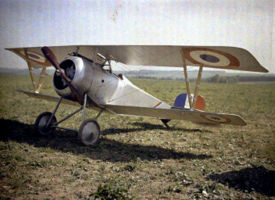PlaneSpottingWorld welcomes all new members! Please gives your ideas at the Terminal.
Nieuport 17
| Nieuport 17 | |
|---|---|
| Type | Fighter |
| Manufacturer | Nieuport |
| Maiden flight | January 1916 |
| Primary user | Aéronautique Militaire |
The Nieuport 17 was a French biplane fighter aircraft of World War I, manufactured by the Nieuport company.
Contents
Design and development
It was a slightly larger development of the earlier Nieuport 11, and had a more powerful engine, larger wings, and a more refined structure in general. At first, it was equipped with a 110 hp (82 kW) Le Rhône 9J engine, though later versions were upgraded to a 130 hp (97 kW) engine. It had outstanding maneuverability, and an excellent rate of climb. Unfortunately, the narrow lower wing - which marked it as a "sesquiplane" design, with literally "one-and-a-half wings" - was weak and had a disconcerting tendency to disintegrate in flight, from the lower wing's single spar construction.
Initially the Nie 17 retained the above wing mounted Lewis gun of the "11", but, at least in French service, this was generally replaced by a synchronised Vickers gun. In the Royal Flying Corps, the wing mounted Lewis was usually retained, by now on the improved Foster mounting, a curved metal rail which allowed the pilot to bring the gun down in order to change drums or clear jams. A few individual aircraft carried both guns - but in practice this reduced performance unacceptably.
Operational history
The type reached the French front in March 1916, and quickly began to replace the Nieuport 11 in French service. It was also ordered by the Royal Flying Corps and Royal Naval Air Service, as it was superior to any British fighter at that time. Worthy of note is the fact that during part of 1916 the Nie 17 equipped every fighter squadron of the Aviation Militaire. The Germans supplied captured examples to several of their aircraft manufacturers for them to copy. This resulted in the Siemens-Schuckert D.I which, apart from the engine installation, was a close copy and actually went into production, although in the event it was not used operationally on the Western Front.
By early 1917, the Nieuport was outclassed in most respects by the latest German fighters. Newer models (the Nieuport 24 and the 27) were brought out in an attempt to retain the type's ascendency. However, the SPAD S.VII had already replaced the Nieuport fighters in many French squadrons by that summer.
Many Allied air aces flew Nieuport fighters, including Canadian ace W.A. Bishop, who received a Victoria Cross while flying it, and (most famously of all) Albert Ball.
Operators
- Template:BEL
- Template:CHI
- Template:COL
- Template:CZS (post-war)
- Template:EST
- Template:FIN
- Template:FRA
- Template:Country data Hungary
- Template:Country data Italy
- Template:NLD
- Template:POL
- Template:Country data Romania
- Template:Country data Russian Empire
- Template:Country data Thailand Siam (Thailand)
- Template:USSR
- 22px Ukraine Template:Country data Ukraine
- Template:UK
- Template:Country data United States
Common cultural appearace
In the movie "Flyboys" (2006) the young american volunteer pilots fly Nieuport 17s.
Specifications (Nie 17)
General characteristics
- Crew: one, pilot
- Length: 5.8 m (19 ft)
- Wingspan: 8.2 m (26 ft 9 in)
- Height: 2.4 m (7 ft 10 in)
- Wing area: 14.75 m² (158.77 ft²)
- Empty weight: 375 kg (827 lb)
- Loaded weight: 560 kg (1,235 lb)
- Powerplant: 1× Le Rhône 9J 9-cylinder rotary engine, 82kW (110 hp)
Performance
- Maximum speed: 164 km/h (88.5 knots, 102 mph)
- Range: 249 km (134.5 nm, 155 miles)
- Service ceiling: 5,300 m (17,390 ft)
- Rate of climb: 11.5 min to 3,000 m (9,840 ft) ()
- Wing loading: 37.9 kg/m² (7.77 lb/ft²)
- Power/mass: 0.15 kW/kg (0.09 hp/lb)
Armament
Sources
- Nieuport Fighters in Action published by Squadron/Signal Publications
- Cheesman E.F. (ed.) Fighter Aircraft of the 1914-1918 War Letchworth, Harletford Publications, 1960 pp. 94-95
See also
Related development
Comparable aircraft
Siemens-Schuckert D.I
Fokker Dr.I
Designation sequence
12 -
14 -
16 -
17 -
18 -
20 -
21
Related lists
See also
Lists relating to aviation | |
|---|---|
| General | Timeline of aviation · Aircraft · Aircraft manufacturers · Aircraft engines · Aircraft engine manufacturers · Airports · Airlines |
| Military | Air forces · Aircraft weapons · Missiles · Unmanned aerial vehicles (UAVs) · Experimental aircraft |
| Notable incidents and accidents | Military aviation · Airliners · General aviation · Famous aviation-related deaths |
| Records | Flight airspeed record · Flight distance record · Flight altitude record · Flight endurance record · Most produced aircraft |
Lists relating to aviation | |
|---|---|
| General | Timeline of aviation · Aircraft · Aircraft manufacturers · Aircraft engines · Aircraft engine manufacturers · Airports · Airlines |
| Military | Air forces · Aircraft weapons · Missiles · Unmanned aerial vehicles (UAVs) · Experimental aircraft |
| Notable incidents and accidents | Military aviation · Airliners · General aviation · Famous aviation-related deaths |
| Records | Flight airspeed record · Flight distance record · Flight altitude record · Flight endurance record · Most produced aircraft |
cs:Nieuport 17 de:Nieuport 17 fr:Nieuport 17 no:Nieuport 17 pl:Nieuport 17 fi:Nieuport 17

